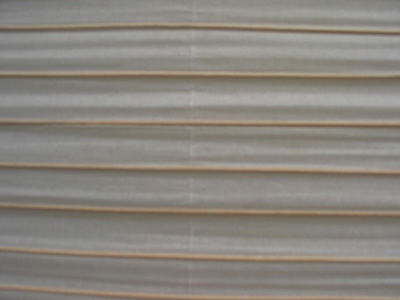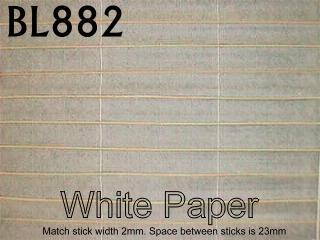
BL882 Series
SHOJI - WHITE PAPER ROLL UP BLINDS





 HOW TO HANG A BLINDClick to view.
HOW TO HANG A BLINDClick to view.
Blinds are packed extra well!
No valance is needed.
All our blinds can be hung inside or outside mount.
Delivery time in business days to most states:
Order Now!
Shopping Cart Order Now
107 - 5219 192nd Street, Surrey, BC, V3S8E5
TELEPHONE (604)574-5060 or (800)990-3445 - FAX. (604)574-7060
email. sales@tropitek.net
 |
 |

Matchstick blinds
Matchstick blinds are an inexpensive form of window covering. Originally made from bamboo, matchstick blinds are now also made from rattan, jute and other woods woven together with natural grasses and reeds. Whatever material is used in their construction matchstick blinds are cut to 1/8 inch diameter; hence the 'matchstick' name. Matchstick blinds come in two main styles: as a standard roller blind or the more decorative roman blind (which creates pleats when raised).
Most of the major manufacturers such as Levelor, American and Bali produce matchstick blinds and they are available in a wide range of sizes at a premium cost. If they don’t fit your window exactly they are fairly easy to tailor at home (due to the thinness of the slats). Many people choose matchstick blinds as a way of bringing the outdoor feeling inside, hence their popularity in conservatories.
Matchstick blinds are available in a variety of natural colours thanks to the different woods used in construction. However, if you fancy something more individual (or a change from the present colour of your matchstick blind) they are easy to decorate at home. It may sound obvious, but you’ll need to first take them down and save the painting for outdoors. For overall painting you should consider using spray paint or a paint gun as this will give a cleaner and more even finish (and don’t try to cut corners by just painting one side).
Other ways to cheer up tired looking matchstick blinds include: replacing the cord with ribbon, creating a striped effect by masking off areas with tape then painting, or investing in some stencils and a well-loaded stippling brush. Whichever route you choose to follow matchstick blinds are one of the easiest and cheapest ways of personalizing a room. However, they serve more of a decorative than a practical function and aren’t much use at keeping sunlight out.
Bamboo blinds
Bamboo blinds have been around for many centuries. Even the Zen teaching of the great Fa-yen of Ch'ing-liang uses a metaphor involving the rolling up and letting down of Bamboo blinds to comment on the issue of loss and gain. He once said of bamboo blinds:'When they are rolled up the great sky is bright and clear, but the great sky still does not match our Way. Why don't you throw away that sky completely? Then not a breath of wind will come through'
Luckily, there are more options with bamboo blinds today. It is no longer necessary for the blind to rest fully open or closed (although you shouldn’t let the great Fa-yen stop you if you so desire it), and they can now be arranged to let just the right amount of light to enter the room.
The making of bamboo blinds in Japan dates back to before the Heian period (794-1185), when they were first used as screens inside Imperial palaces and in the homes of noblemen. Even today bamboo contributes to almost every aspect of life in Japan and is used for everything from scaffolding to crafting children’s toys. Bamboo’s strength and versatility makes it a unique manufacturing material and some varieties shoot up so quickly that they literally grow before your eyes.
Although bamboo blinds are freely available in the West, in China bamboo blind manufacturing is maintained as a traditional craft; involving both manual and mechanical procedures. Bamboo is cut during October when moisture levels are low, the skin is then stripped using a curved knife and the bamboo is split into eight sections. These are then threaded into a binding machine where the pieces of bamboo are woven together (traditionally with silk). Manufacturers’ justifiably claim the traditional methods of construction imbue the blind a little of the beauty, atmosphere and elegance of the East.
In Malaysia, bamboo blinds have taken on a more unusual use. When the heat of the sun becomes too intense, the shopkeepers lower their bamboo blinds and the place takes on a different look. Here, the bamboo blinds serve a dual purpose: not only are they used to provide shade, they are also the perfect canvas for advertising the shop and what it has to sell.
updated 09-02-17 www.bctropicalshells.com/buri/buri9-bl882.htm